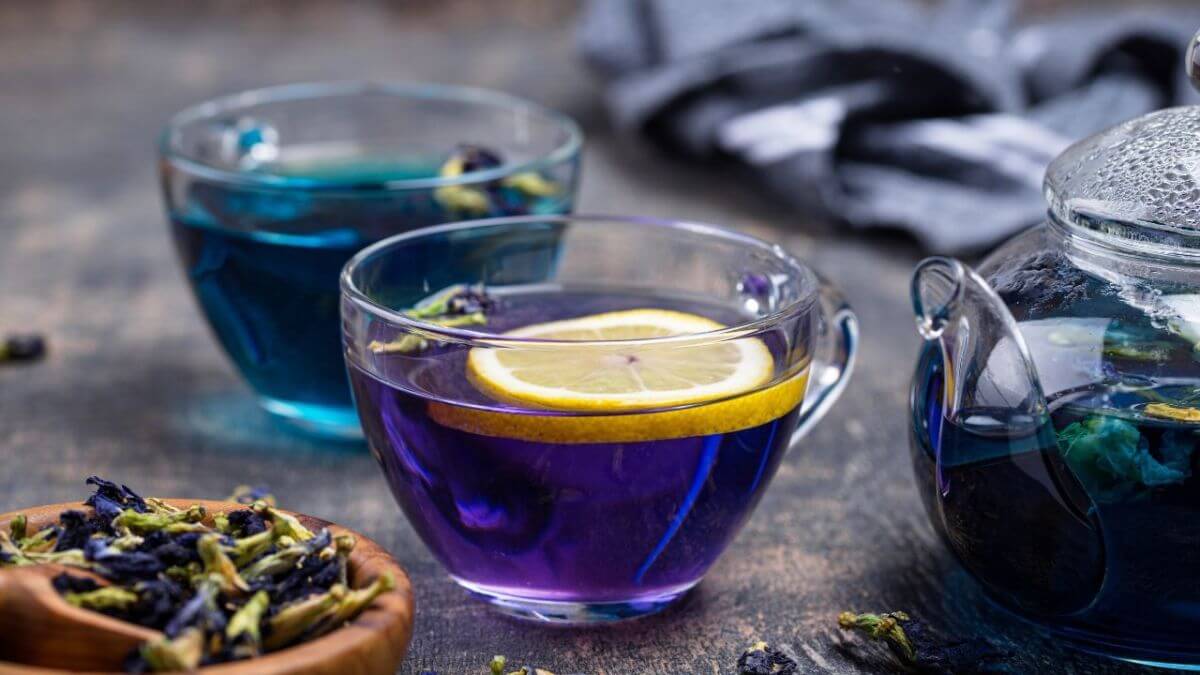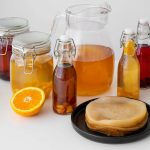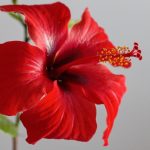30 Oct Butterfly Pea Flower Blue Tea: how to make tea that changes colour
Blue tea, popularly known as Butterfly Pea Flower, is an infusion famous for its vibrant colours. Made from the flowers of Clitoria ternatea, it is typically of an intense blue hue, which can turn purple or pink when other ingredients are added.
The fascinating process of preparing this tea and its many uses make it a highly sought-after product in many areas and for many purposes. In this article, we’ll explore this tea and some of its applications.

font: caloriebee
What is blue tea?
Clitoria ternatea is native to the Indonesian island of Ternate, but it’s common to find it all over South and Southeast Asia. It can also be found in Africa, Oceania, and the Americas, having been introduced there by human hands. Blue tea has been consumed in its native countries for centuries, mostly by indigenous peoples, but only recently has it become known to other consumers.
The blue colour of its flowers is caused by anthocyanins, antioxidant compounds also found in grapes, blueberries, and blackberries. Typically, the flowers are picked and then dried, and it is the dried petals that are used in tea. The infusion of these leaves then releases a vibrant blue dye that can be used as a natural colouring in a variety of applications.
However, all it takes is the addition of an acidic ingredient to transform its colour. Just a few drops of lemon or lime juice to turn the blue colour purple. And all it takes is a few hibiscus petals for purple to turn red. This fascinating mutation is associated with changes in the ph of tea and is one of the reasons for its international popularity.
In India, this flower is named after the Hindu goddess Aparajita, and in Thailand the drink is called Anchan.
Its uses
Its earthy flavour, similar to green tea, makes this infusion a simple and interesting drink for any tea fan. Combined with other ingredients, such as herbs and fruits, you can achieve peculiar and visually intriguing tisanes. In Thailand and Vietnam, it is common to drink this tea with honey and lemon, consumed after dinner, or served in hotels and spas as a refreshment. In Thai, it is known as nam dok anchan, and in its cold version it is also common to add mint, cinnamon, passion fruit and ginger, in addition to honey and lemon.
However, not only in tea is this flower popular: its vibrant blue colour, so easy to obtain, is highly popular in cooking, cocktail making and cosmetics. It is a popular ingredient in Thai and Malaysian cuisine, as a colouring agent for desserts and rice, such as the typical sticky rice and various other traditional delicacies.
In traditional Ayurvedic medicine, blue tea is described as having anti-stress, anxiolytic, antidepressant and sedative qualities. In traditional Chinese medicine, it is used as a female libido enhancer, due to the flower’s resemblance to the female reproductive organ.
It is also frequently used to dye fibres and clothing, especially in traditional Asian communities.
Medicinal properties and benefits
The antioxidant and anti-inflammatory properties of this tea are recognised in modern medicine. Some studies suggest that this tea benefits skin and hair health, promotes weight loss and helps regulate blood sugar levels.
What’s more, the presence of antioxidants, anti-inflammatories, antivirals and anti-carcinogenic properties are being studied. Its potential to strengthen the immune system is also being investigated.
How to make Blue Tea
Blue tea petals are easy to infuse and don’t develop bitter flavours as easily and quickly as green tea. So although it’s not free from becoming more bitter if left to infuse for too long, it’s a safer, caffeine-free alternative for those who enjoy the flavour of green tea.
Simple butterfly pea flower tea
- 1 teaspoon of blue tea flowers
- 1 cup of water
Heat the water to between 80º and 90º and add the tea flowers. Leave to infuse for about 5 minutes. Remove from the heat, strain and serve.
Butterfly pea flower iced tea
- 4 teaspoons of blue tea flowers
- 1 litre water
- jug with lid
Add the flowers to a jug of water and leave in the fridge overnight. The next day, strain and serve. You can add honey to sweeten.
Butterfly pea flower tea with cinnamon and ginger
- 1 teaspoon of blue tea flowers
- 1 cup water
- 1 cinnamon stick
- 1 teaspoon ginger root
Heat the water to between 80º and 90º and add the tea flowers, cinnamon, and ginger. Leave to infuse for about 5 minutes. Remove from the heat, strain and serve.
Changing the colour of blue butterfly pea flower tea
Purple butterfly pea flower tea
- 1 teaspoon blue tea flowers
- 1 teaspoon lemon juice
- 1 cup water
Heat the water to between 80º and 90º and add the tea flowers. Leave to infuse for about 5 minutes. Remove from the heat. Add the lemon juice and wait for the drink to turn purple. Serve.
Red butterfly pea flower tea
- 1 teaspoon of blue tea flowers
- 1 cup water
- 1 teaspoon lemon juice
- 1 hibiscus flower
Heat the water to between 80º and 90º and add the tea flowers. Leave to infuse for about 5 minutes. Remove from the heat. Add the lemon juice and wait for the drink to turn purple. Then add the hibiscus flower. Strain and serve when it has the desired colour.
Whether you want to surprise your guests or add some natural colour to your drinks, butterfly pea flower tea is an elegant and easy-to-make tea. Its beauty and flavour will undoubtedly fascinate everyone who comes across this drink.








Catherine Houchins
Posted at 09:48h, 01 NovemberYour writing is like a breath of fresh air.